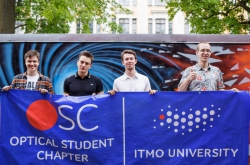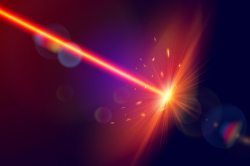The COMSOL Day is held monthly in various parts of the world. In the end of October, one such event took place in Moscow. Its program included workshops, training sessions, and lectures from guest speakers. Specialists who actively publish the results of their work with COMSOL Multiphysics software and develop new algorithms for it are invited to present their ideas. During the Moscow event, there were three such speakers, Alexander Shalin among them.
COMSOL Day’s organizers had taken notice of the Nano-Opto-Mechanics Lab. The Lab’s Facebook and VK pages regularly published the scientific results gained through the use of Multiphysics software.
“Any program needs to be applied correctly or it will produce faulty results. In nano- and optomechanics, one needs to correctly pick the geometry of the objects being examined and the surrounding space, as well as boundary conditions, and then compare this data with analytics. If we don’t do it right, we get miscalculations. Working on new fundamental physics in any type of program is a challenge, since you’re working with something nobody has done before. You can’t just grab a complete model from a built-in library – you have to make one yourself and figure out not only the software tools, but the physics of it, too. Sometimes, even tried-and-true methods don’t work and you have to find different solutions,” – says Dr. Shalin.

COMSOL Multiphysics software
Current research
At COMSOL Day, Alexander Shalin spoke about the calculation of optical and plasmon power and, particularly, about modeling the behavior of dipole nanoparticles on plasmon surfaces and how these can be controlled using plane waves and Gaussian beams. This way, a nanoparticle can be drawn to the emitter, creating a so-called “tractor beam”.
Focused laser beams can be used to transfer objects only when dealing with microparticles. However, when used with nanoparticles, Brownian motion has the stronger effect and pushes them out of the beam’s path. To prevent that, it is necessary to employ additional systems or conditions. At the Nano-Opto-Mechanics Laboratory, plasmon-polaritons are used to create such conditions. Those are surface waves that propagate along the surfaces of various metals. If a nanoparticle placed on such a surface comes in contact with a laser, nothing will occur and the plasmon-polaritons spread in a symmetrical manner. However, if the particle is hit by a laser of certain properties and from a particular angle, single-direction plasmon-polaritons can be excited. Due to the law of conservation of momentum, a reactive force occurs, pushing the particle into the direction opposite to that of the plasmon-polaritons, i.e. in the direction of the emitter (you can read about the other methods of creating tractor beams using optical, acoustic or water waves in our previous article).
In addition, the Laboratory is developing methods of amplifying the strength of optical traps. Those are used to study microobjects – including living tissue cells – and to manipulate microparticles and suspend them in immobile state. For that purpose, they are hit by a focused laser of necessary wavelength and intensity. The tool used for that procedure is referred to as an optical trap or optical tweezers (read more about the use of optical traps in biological studies here).

Specialists from ITMO University have demonstrated that, if a nanoparticle is placed on a metal surface and targeted by a focused Gaussian beam, it is possible to excite single-direction plasmon-polaritons which can either help trap a particle in the beam’s vortex or, on the contrary, push it out. By modifying the beam’s parameters, scientists can capture or push out particles of a specific size, thereby sorting them. The importance of the team’s research is that they have developed a system that uses a beam of lesser intensity than its counterparts. This helps reduce the likelihood of a particle burning up in the beam and increases the likelihood of capture.
Alexander Shalin’s research team also models systems for the alignment and self-organization of nanoparticles on metal surfaces using unidirectional plasmon-polaritons. Since the wavelength of plasmon-polaritons is shorter than that of optical waves, particles can be positioned with better precision by modulating the properties of both the beam and the surface. Interference between surface plasmon-polaritons and propagating electromagnetic waves can be used to create nanoobject grids on metal surfaces with various, even anisotropic parameters. This approach can thus be used to implement a new method for optical self-organization of nano-particles on surfaces.
Other reports from COMSOL Day
Two other speakers presented their work at COMSOL Day. Sergey Popkov, senior researcher at the Sedakov Research Institute of Measuring Systems, described the use of new modeling algorithms in working with piezoresistive sensors. Oksana Limanovskaya, assistant professor at the Ural Federal University, described her work on the modeling of electrochemical processes.

Alexander Shalin
“I found the second report interesting as it has a lot of future. At our lab, we want to bring together chemistry and metamaterial-and-nanostructure optics and use the unusual properties of nanostructures to control chemical processes. The event was also an opportunity to establish contact with specialists in the field of thin nano-coatings – which can be used to improve the anti-reflection properties of optical elements and increase the effectiveness of thin-film solar cells by creating light-harvesting surfaces. We’ve been developing such surfaces at ITMO University for some time now and are currently close to patenting our product and introducing it to the market,” – adds Shalin.
The laboratory also works with dielectric nanophotonics, i.e. creating nanostructures using dielectrics in order to control the phase and geometry of light beams and their reflection. They can also be used to develop solutions for holography tasks and produce anti-reflective nanostructure coatings for lenses. The laboratory collaborates with specialists from the Hannover Laser Center (Germany), the University of Central Florida (USA), Aalto University (Finland), St Petersburg Academic University of the Russian Academy of Sciences and other scientific institutions. Each of the laboratory’s departments is supervised by experts from ITMO University and its international partners.





